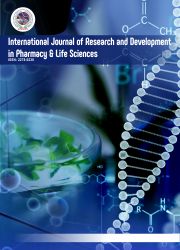NEUROPROTECTIVE ROLE OF MUCUNA PRURIENS IN PARKINSON’S DISEASE MODEL SYSTEM
Keywords:
Parkinson’s disease (PD), M. pruriens, Neurodegeneration, NeurogenesisAbstract
Parkinson's disease (PD) is a second most common neurodegenerative disease and characterized by the progressive degeneration of the dopaminergic (DA) pathway. 1-Methyl-4-phenyl-1,2,3,6-tetrahydropyridine (MPTP) causes damage to the DA neurons. Treatment for this disease is still under investigation. Mucuna pruriens (Kivach), is a traditional herbal medicine, used in India since 1500 B.C., as a neuroprotective agent. In this present study, we have evaluated the therapeutic effects of M. pruriens seed extract (MPSE) in Parkinsonian mouse model. Experimental study comprised of four groups having Swiss albino mice (30-45grams) grouped as follows: Control (A), MPTP (B), MPSE (C), and MPTP+ MPSE (D), 6 mice in each group. Experimental mice were given M. pruriens seed extract treatment orally 48mg/kg bodyweight for one month with prior use of 15mg/kg b.w of MPTP treatment for two weeks. After the treatment, behavioral study was performed and assessment of Neuroprotective effect was studied via enzymatically and other molecular parameters. We observed a significant reduction in activity of tyrosine hydroxylase (TH) positive neurons in the substantia nigra (SN) region of brain, after treatment with MPTP and this activity was considerably restored by the use of MPSE. Our result suggested that MPSE treatment reduces the oxidative stress; prevent dopaminergic neurodegeneration through increase in numbers of TH positive neurons, thereby proving its antioxidant, neuroprotective and neurogenic properties. Results of this study support further investigations on this plant, as possible therapeutic intervention against Parkinson's disease.
Downloads
References
Dauer W & Przedborski S. (2003). Neuron. 39: 889-909
Behari M, Achal K & Srivastavaa P. (2005). Parkinsonism Relat Disord. 11: 221-226
Liu SM, Li XZ, Huo Y & Lu F. (2012). Phytomedicine.19: 631-638
Schapira AHV, Bezard E, Brotchie J, Calon F,Collingridge GL, Ferger B, Hengerer B,Hirsch E, Jenner P,Spampinato U & Davidai G. (2006). Nature Reviews Drug Discov. 5: 845-854
Koutsilieri E, Scheller C, Tribl F, & Riederer P. (2002). Parkinsonism and Related Disorders. 8: 401-406
Liberatore GT, Jackson-Lewis V & Vukosavic S. (1999). Nature Medicine. 5:1403-1409
Choi DK, Pennathur S & Perier C. (2005). The Journal of Neuroscience. 25: 6594-6600
Wu D, Teismann P & Tieu K. (2003). Proceedings of the National Academy of Sciences of the United States of America. 100: 6145-6150
Gao H, Liu B, Zhang W & Hong J. (2003). The FASEB Journal. 17:1954-1956
Singh S & Dikshit M. (2007). Brain Research Reviews. 54: 233-250
More SV, Kumar H, Kim IS, Koppulla S, Kim BW & Choi DK. (2013). CNS & Neurological Disorders Drug Targets. 12: 680-697
Cannon JR & Greenamyre GT. (2010). Recent advances, Progress in Brain Research. 184: 17-33
Fox SH & Brotchie JM. (2010). Progress in Brain Research. 184: 133-157
Fahn S. (2008). In: Nass R, Przedborski S, editors, Parkinson’s Disease, Elsevier; Amsterdam
Brooks DJ. (2008). Neuropsychiatr Dis Treat. 4: 39-47
Rascol O, Lozano A, Stern M & Poewe W. (2011). Mov Disord. 26: 1072-1082
Ramya KB & Thaakur S. (2007). Anc Sci Life. 27: 50-55
Seidl SE & Potashkin JA. (2011). Frontiers in Neurology. doi: 10.3389/fneur.2011.00068
Pandey GS & Chunekar KC. (1996). Bhavprakash nighantu Chaukhamba Vidhyabavan, Varanasi. 357-359
Ovallath S & Deepa P. (2013).Mov Disord. 28: 566-568
Manyam BV, Dhanasekaran M & Hare T. (2004). Phytother Res.18: 706-612
Tripathi Yamini B & Upadhyay AK. (2002). Phytother Res. 16: 534-538
Gibrat C, Saint-Pierre M, Bousquet M, Levesque D, Rouillard C & Cicchetti F. (2009). Journal of Neurochem, 109: 1469-1482
Kasture S, Pontis S, Pinna A, Schintu N, Spina L, Longoni R, Simola N, Ballero M & Morelli M. (2009).Neurotoxin Res. 15: 111-122
Ali MM, Mathur N & Chandra SV. (1990). Indian J Exp Biol. 28: 653-656
Terry AV, Stone Jr JD, Buccafusco JJ, Sickles DW, Sood A & Prendergast MA. (2003). J. Pharmacol. Exp. Ther, 305: 375-384
Ohkawa H, Ohishi N, & Yagi K. (1997). Annals of Biochemistry, 95: 351-358
Aebi H, Catalase in vitro. In: Packer, L. (Ed.), Methods in Enzymology 105, Academic Press, New York, 1984, 121
McCord JM, & Fridovich I. (1969). Journal Biol Chem. 224: 6049-6055
Goslin K, Schreyer DJ, Skene JHP & Banker G. (1990). Jour Neurosci. 10: 588-602
Shingo T, Date I, Yoshida H & Ohmoto T. (2002). JNeurosci Res. 69: 946-954
Tiwari SK, Agarwal S, Seth B, Yadav A, Nair S, Bhatnagar P & Chaturvedi RK. (2014). ACS Nano. 8: 76-103
Dias V, Junn E & Mouradian MM. (2013). Journal of Parkinson’s Disease. 3: 461-491
Manyam BV, Dhanasekaran M & Hare TA. (2004). Phytother Res. 9: 706-712
Sathiyanarayanan L & Arulmozhi S. (2007). Pharmacogn Rev.1: 157-162
Lieu CA, Venkiteswaran K, Gilmour TP, Rao AN, Petticoffer AC, Gilbert EV, Deogaonkar M, Manyam BV & Subramanian T. (2012).Evid. Based Complement Alternat Med, 2012: 840247
Yadav SK, Prakash J, Chouhan S & Singh SP. (2013). Neurochem Int. 62: 1039-1047
Huot P, Johnston TH, Koprich JB, Fox SH & Brotchie JM. (2013). Pharmacol Rev. 65: 171-122
Graham DG. (1978). Molecular Pharmacology.14: 633-647
Nicklas WJ, Vyas I, &Heikkila RE. (1998). Life Sciences. 36: 2503-2508
Iczkiewicz J, Jackson MJ, Smith LA, Rose S & Jenner P. (2006). Brain Research.1118: 239-250
Chaturvedi RK, Shukla S, Seth K, Chauhan S, Sinha C & Shukla Y. (2006). Neurobiology of Disease. 22: 421-434
Sharma ML, Chandhoke N, Ray Ghatak BJ, Jamwal KS, Gupta OP & Singh GB. (1978). Indian J Exp Biol16: 228-235
Misra L & Wagner H. (2007). Indian J Biochem Biophys. 44: 56-60
Shukla KK, Mahdi AA,Ahmad KM, Jaiswar SP, Shankwar SN & Tiwari SC. (2010). eCAM. 7:137-144
Aznavour N, Cendres-Bozzi C, Lemoine L, Buda C, Sastre JP & Mincheva Z. (2012). CNS Neuroscience & Therapeutics. 18: 934-941
Agrawal AK, Chaturvedi RK, Shukla S, Seth K, Chauhan S, & Ahmad A. (2004). Journal Chem Neuroanat. 28: 253-264.
Published
How to Cite
Issue
Section

This work is licensed under a Creative Commons Attribution-NoDerivatives 4.0 International License.







 .
.